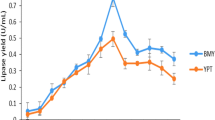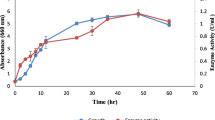Abstract
Response surface methodology was employed to optimize culture medium for production of lipase with Rhodotorula sp. MTCC 8737. In the first step, a Plackett–Burman design was used to evaluate the effects of different inducers qualitatively. Of all the seven inducers tested, soybean oil showed significant influence on the lipase production. Further, response surface studies were conducted to quantitatively optimize by considering linear, interactive, and quadratic effects of test variables. A novel approach was proposed to optimize the lipase production system by optimizing the responses in terms of yield kinetics rather than optimizing the direct responses like lipase titer and biomass growth. The coefficient of determination (R 2) calculated for Y P/S (0.769), Y P/X (0.799), and Y X/S (0.847) indicated that the statistical model could explain 76.9%, 79.99%, and 84.7% of variability in the response.





Similar content being viewed by others
References
Sharma, R., Chisti, Y., & Banerjee, U. C. (2001). Biotechnology Advances, 19, 627–662. doi:10.1016/S0734-9750(01)00086-6.
Rajendran, A., & Thangavelu, V. (2007). Journal of Chemical Technology and Biotechnology (Oxford, Oxfordshire), 82, 460–470. doi:10.1002/jctb.1691.
Akhnazarova, S., & Kafarov, V. (1982). Experiment optimization in chemistry and chemical Engineering. Moscow: Mir Publications.
Myers, R. H., & Montgomery, D. C. (1995). Response surface methodology: process and product optimization using designed experiments (1st ed.). New York: Wiley-Interscience.
Khuri, A. I., & Cornell, J. A. (1987). Response surfaces: design and analysis. New York: Marcel Dekker Inc.
Ravichandra, P., Subhakar, C., Pavani, A., & Annapurna, J. (2008). Bioresource Technology, 99, 1776–1786. doi:10.1016/j.biortech.2007.03.041.
Gupta, N., Sahai, V., & Gupta, R. (2007). Process Biochemistry, 42, 518–526. doi:10.1016/j.procbio.2006.10.006.
Ravi, N. V., Ravichandra, P., & Lakshmi, N. M. (2008). Applied Biochemistry and Biotechnology. doi:10.1007/s12010-008-8315-z.
Ravichandra, P., Mugeraya, G., & Annapurna, J. (2008). Applied Biochemistry and Biotechnology. (doi.org/10.1007/s12010-008-8229-9).
Himabindu, M., Ravichandra, P., Vishalakshi, K., & Annapurna, J. (2006). Applied Biochemistry and Biotechnology, 134, 143–154. doi:10.1385/ABAB:134:2:143.
Radhika, T., Kiran Kumar, D., Ravichandra, P., & Lakshmi Narasu, M. (2007). Applied Biochemistry and Biotechnology, 141, 187–201. doi:10.1007/BF02729061.
Ravichandra, P., Subhakar, C., Vanajakshi, J., & Annapurna, J. (2008). Applied Biochemistry and Biotechnology. doi:10.1007/s12010-008-8293-1.
Plackett, R. L., & Burman, J. P. (1946). Biometrika, 33, 305–325. doi:10.1093/biomet/33.4.305.
Bursali, N., Ertunc, S., & Akay, B. (2006). Chemical Engineering and Processing, 45, 980–989. doi:10.1016/j.cep.2006.02.010.
Winkler, U. K., & Stuckmann, M. (1979). Journal of Bacteriology, 138, 663–670.
Dubois, M. (1956). Analytical Chemistry, 28, 350–356. doi:10.1021/ac60111a017.
Montgomery, D. (2001). Design and analysis of experiments (5th ed.). New York: Wiley.
Cochran, W. G., & Cox, G. M. (1957). In: Experimental design (pp. 346–354). 2nd ed. New York: John Wiley and Sons.
Box, G. E. P., Hunter, W. G., & Hunter, J. S. (1978). In: Statistics for experimenters (pp. 291–334). New York: John Wiley and Sons.
He, Y. Q., & Tan, T. W. (2006). Journal of Molecular Catalysis. B, Enzymatic, 43, 9–14.
Acknowledgment
The authors are thankful to Dr. J.S. Yadav, Director, Indian Institute of Chemical Technology, Hyderabad, India for his encouragement. One of the authors, Subhakar Chennupati, thanks CSIR, New Delhi, India for SRF fellowship.
Author information
Authors and Affiliations
Corresponding author
Rights and permissions
About this article
Cite this article
Chennupati, S., Potumarthi, R., Gopal Rao, M. et al. Multiple Responses Optimization and Modeling of Lipase Production by Rhodotorula mucilaginosa MTCC-8737 Using Response Surface Methodology. Appl Biochem Biotechnol 159, 317–329 (2009). https://doi.org/10.1007/s12010-009-8547-6
Received:
Accepted:
Published:
Issue Date:
DOI: https://doi.org/10.1007/s12010-009-8547-6




